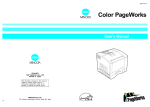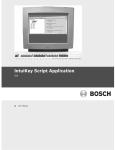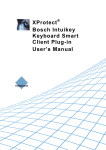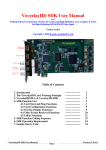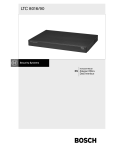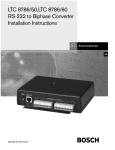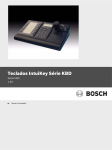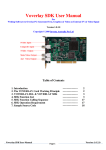Download Bosch IntuiKey Instruction manual
Transcript
KBD-SFTCFG
Instruction Manual
EN Software for the
IntuiKey Series Digital
Keyboard Software
Version 1.80
KBD-SFTCFG | Instruction Manual | Contents
EN | 2
Table of Contents
1.0
INTRODUCTION ....................................................................................................................................................3
2.0
REQUIREMENTS ....................................................................................................................................................3
3.0
KBD-SFTCFG INPUT LOCALES ..........................................................................................................................3
4.0
PARTS LIST ................................................................................................................................................................3
5.0
OPTIONAL ACCESSORIES ..................................................................................................................................3
6.0
INSTALLATION ........................................................................................................................................................4
6.1
Software Installation ....................................................................................................................................................4
6.2
RS-232 Connection ....................................................................................................................................................4
6.3
Keyboard Preparation ................................................................................................................................................4
7.0
KBD-SFTCFG STARTUP ........................................................................................................................................5
8.0
KBD-SFTCFG VIEWS ..............................................................................................................................................5
8.1
Tree Control (Left Pane) ............................................................................................................................................5
8.2
Forms (Right Pane) ......................................................................................................................................................6
8.2.1 Language Table Forms ....................................................................................................................................6
8.2.2 Miscellaneous String Forms ............................................................................................................................6
8.2.3 Error Message Forms ......................................................................................................................................6
8.2.4 User Function Forms ........................................................................................................................................6
8.2.5 Softkey Menu Forms ........................................................................................................................................6
9.0
KBD-SFTCFG MENUS ............................................................................................................................................7
9.1
File Menu ......................................................................................................................................................................7
9.2
Edit Menu ....................................................................................................................................................................7
9.3
View Menu ..................................................................................................................................................................8
9.4
Transfer Menu ..............................................................................................................................................................8
9.5
Server Menu ................................................................................................................................................................9
9.6
Window Menu ..........................................................................................................................................................10
9.7
Help Menu ..................................................................................................................................................................10
10.0
Using the KBD-SFTCFG ..........................................................................................................................................10
10.1
Why the 1 – English Language Table Cannot be Modified ................................................................................10
10.2
Editing Text ................................................................................................................................................................10
10.2.1 Text Alignment ..............................................................................................................................................10
10.2.2 Inputing Font Characters by their Numeric Code-Points ..........................................................................11
10.3
Changing a Language Table’s Name ......................................................................................................................11
10.4
Link Buttons ..............................................................................................................................................................11
10.5
Configuring Softkeys to Execute (CCL) Command Script Macros ....................................................................12
10.5.1 Assigning Macros ............................................................................................................................................12
10.5.2 Organizing IntuiKey Configuration (.int) Files per Allegiant® Server (.alg) Files ................................12
10.6
Uploading Language Tables ....................................................................................................................................12
APPENDIX A – Keyboard Font Tables ............................................................................................................................13
APPENDIX B – RS-232 Interface Cable Detail (Part Number S1385) ........................................................................20
APPENDIX C – Allegiant Command Scripts and the KBD-SFTCFG ........................................................................21
APPENDIX D – Intuikey and KBD-SFTCFG Compatibility ........................................................................................22
Bosch Security Systems | December 02, 2005
EN | 3
KBD-SFTCFG | Instruction Manual | Introduction
1.0 INTRODUCTION
2.0 REQUIREMENTS
The BOSCH KBD-SFTCFG (IntuiKey Configuration
Software) is used to customize the text displays and
Command Script (CCL) macro associations of BOSCH
IntuiKey Series keyboards.
The KBD-SFTCFG can only be used on PCs which
have the following:
The KBD-SFTCFG creates IntuiKey Configuration
(.int) files which contain one or more language tables.
In general, a language table is a collection of text that
an IntuiKey keyboard displays on its LCDs, plus a
collection of commands that allow IntuiKey keyboards
to execute Command Script (CCL) macros on a
BOSCH Allegiant® matrix switcher/controller system.
Although IntuiKey keyboards can store no more than
8 language tables at once, IntuiKey Configuration (.int)
files can hold as many language tables as the PCs
resources will allow. When an IntuiKey keyboard has
been connected to a PC with an RS-232 interface
cable, language tables can be transferred between the
KBD-SFTCFG software and the keyboard.
When a new IntuiKey Configuration (.int) file is
created, it will contain several language tables. The
language tables are identical in function, but their text
has been translated into different languages which may
include English, Spanish, Dutch, French, German,
Italian, Polish, Portuguese, Czech, Russian, Slovak,
Simplified Chinese, Traditional Chinese, or Korean. This
text can be customized as needed (perhaps translated
into yet other languages) using any characters available in
the keyboard’s font tables. (see APPENDIX A).
PC Running KBD-SFTCFG
Sofware and Optional Allegiant
Configuration Software Programs
•
Pentium® CPUs (or better)
•
CD-Rom Drive
•
1 Serial (COM) Port (2 if the Allegiant
interface will also be used)
•
1 Parallel Port (if running Allegiant software)
•
Microsoft® Windows NT® 4.0 (with Service
Pack 6), Windows 2000® or Windows XP®
3.0 KBD-SFTCFG INPUT
LOCALES
The KBD-SFTCFG is compatible with any of the
Windows® Input Locales available for a PC. However,
it will only accept characters that are contained within
the keyboard’s font tables (see APPENDIX A).
In Windows®, Input Locales are configured with the
Control Panel’s Regional Settings applet.
4.0 PARTS LIST
The KBD-SFTCFG includes the following items:
•
A CD-Rom
•
An RS-232 Interface Cable
(Part Number S1385)
•
Installation Instructions (this manual)
•
A Software License Agreement
5.0 OPTIONAL ACCESSORIES
RS-232 Interface
to IntuiKey Series
Keyboard
Figure 1 – Typical Application Using the KBD-SFTCFG
Bosch Security Systems | December 02, 2005
•
Allegiant LTC 8059/00 Master Control Software
for Windows® Program
•
Allegiant LTC 8850/00 Graphical User Interface
Program
•
IntuiKey Firmware Upgrade Program (available
from the BOSCH Web site at
http://www.boschsecurity.com)
RS-232 Interface
to Allegiant System
(Optional)
EN | 4
KBD-SFTCFG | Instruction Manual | Installation
6.0 INSTALLATION
6.1
Software Installation
Insert the CD into the PC’s CD-ROM drive. If the CD
ROM drive is not configured to autorun, open
Windows Explorer and navigate to the
ICS_Installer.exe. Double click to begin the installation.
6.2
RS-232 Connection
All communication between the IntuiKey Series
keyboard and the KBD-SFTCFG is performed through
an RS-232 interface.
Connect one end of the RS-232 interface cable to the
9-pin RS-232 Serial Port located on the far right side
of the rear of the IntuiKey keyboard. Connect the
other end of the RS-232 interface cable to a COM
port on the PC. The software supports the use of
COM1 through COM16.
IMPORTANT: Before the IntuiKey keyboard will
respond to external RS-232 communication, it must be
placed in bootloader mode. This is done by entering the
IntuiKey keyboard’s Firmware Upgrade menu which is
accessed from the Keyboard Control option of the
main Product List selection screen. When prompted for
the password, press the 1 and 0 numeric keypad
buttons simultaneously. The keyboard will then be in
bootloader mode.
Allegiant
ADIM
Exit
Factory
Reset
Firmware
Upgrade
DVR 1
Unit a
1
Keyboard
Control
Language
Select
Keyboard
Test
LCD
Test
Joystick
Auto Cal.
Contrast
Adjust
Key Click
On/Off
Display
Inverse
Normal
Figure 3 – IntuiKey Keyboard Bootloader Menu Access
MUX / DVR
ALLEGIANT
12 VDC
RS-232 SERIAL PORT
Figure 2 – IntuiKey Keyboard Rear Panel Showing
9-pin RS-232 Interface Connector
If an Allegiant software package (LTC 8059/00 or
LTC 8850/00) will be used simultaneously with the
KBD-SFTCFG, a second COM port must be available
on the PC to interface with the Allegiant system’s
console port. Refer to the manual provided with the
Allegiant software for complete information.
6.3
Keyboard Preparation
First, verify that the keyboard’s firmware version is
1.01 or higher. The firmware version is shown on the
IntuiKey keyboard’s main menu when it is first
powered up. If the firmware version precedes version
1.01, a keyboard firmware update is required before it
can be used with the KBD-SFTCFG. Update the
IntuiKey keyboard’s firmware via the IntuiKey
Firmware Update Utility, available from the Software
Updates section of the BOSCH Web site
(http://www.boschsecurity.com).
Bosch Security Systems | December 02, 2005
In certain circumstances, it may be necessary to enter
bootloader mode when the keyboard is in a state
where the menu selections are not visible or are
otherwise unavailable. In this situation, bootloader
mode can be entered directly by simultaneously
pressing the 1 and 0 numeric keypad buttons while the
power/data cable is attached. The buttons must be released
immediately when the keyboard begins to power up and
initialize. For keyboards with bootloader version 1.01 or
higher, skip the next paragraph.
For keyboard bootloader version 1.00 only, you
must now press the CLR button, power off/on the
keyboard again, allow several seconds for it to boot up
to a menu, then power it off/on while pressing the
1 and 0 numeric keypad buttons as the power/data
cable is attached. Again, release the buttons immediately
when the keyboard begins to power up and initialize.
The keyboard will now be able to communicate with
the KBD-SFTCFG. If multiple transfers will be made,
the keyboard may need to be cleared and the
bootloader mode re-entered after each action.
Keyboard models containing Bootloader version 1.05
or later support the ability to download / upload using
a faster baud rate of 57600. Once you are in the
Bootloader menu, check the lower right section of the
larger LCD screen. If you see the option for baud rate
selection, press the button to select the faster rate. Your
data will transfer three (3) times faster compared to
using the default baud rate of 19200.
EN | 5
KBD-SFTCFG | Instruction Manual | Startup
7.0 KBD-SFTCFG STARTUP
To start the KBD-SFTCFG from the Windows® START
menu, select Programs | IntuiKey | IntuiKey
Configuration Software. The KBD-SFTCFG always
starts in an empty state; i.e., with no IntuiKey
Configuration (.int) files opened for editing:
IntuiKey firmware version number associated with an
open configuration document is displayed in the Status
Bar. The firmware version number of an IntuiKey
keyboard is displayed in its left LCD screen when the
device is first powered up.
8.0 KBD-SFTCFG VIEWS
The KBD-SFTCFG’s main screen is divided into two
views. The left pane contains a tree control that allows
a user to index through a set of language tables (and
their main subsections). The right pane displays a form
that corresponds to the subsection of the currently
selected language table.
The KBD-SFTCFG can support a maximum of 16 .int
files open at once. Each file contains the following:
•
One or more language tables
•
An optional path to an Allegiant server (.alg) file
•
A selection of a PC COM port (for RS-232
communication with the keyboard)
8.1
Tree Control (Left Pane)
The tree’s root node is labeled Language Tables. The
root node’s immediate subnodes (language table nodes)
represent the language tables contained in the IntuiKey
Configuration (.int) file (e.g.: 1 – English).
A language table is associated with one of the font
tables shown in APPENDIX A. The font table number of
the currently selected language table is displayed in the
program’s Status Bar.
To create a new IntuiKey Configuration (.int) file, select
File | New. A dialog will appear with a list of options:
The options shown in the list are the various language
table templates that can be loaded into the program.
For reference purposes, the default templates are named
based on the languages they contain. The name also
includes a number at the end that corresponds to the
compatible version of the IntuiKey firmware. Language
tables can only be downloaded into keyboards that
contain compatible firmware, so it is important to select
the correct template. See APPENDIX D for more
information.
Whenever a KBD-SFTCFG file is saved, it is
recommended that the associated keyboard firmware
version be included at the end of its file name. The
Bosch Security Systems | December 02, 2005
Each language table node has four immediate subnodes
which represent its major subdivisions. They are labeled
as follows: Miscellaneous Strings, Error Messages,
User Functions, and Softkey Menus.
The Softkey Menus node has several subnodes which
represent the language table’s softkey menus. Softkey
menu nodes have labels that generally describe the
collective functionality of their 14 softkeys
(e.g., 31 – Camera Functions).
If a tree node represents a portion of a language
table’s contents, then selecting it will cause those
contents to be displayed in a form in the
KBD-SFTCFG’s right pane.
KBD-SFTCFG | Instruction Manual | Forms
8.2
Forms (Right Pane)
The KBD-SFTCFG’s right pane contains forms which
display portions of a language table’s contents organized
into groups of edit boxes and buttons. Each group
appears directly beneath one or more lines of
descriptive text which explains its significance.
EN | 6
8.2.3 Error Message Forms
These forms display the language table’s error messages.
A keyboard will display these messages on its LCDs to
indicate various types of system and user related errors.
If the language table is not intended to be modified
(i.e., read-only), then its forms’ buttons and edit boxes
will be disabled. 1 - English is a read-only table and
serves as a reference against which other tables can be
compared after they have been modified.
8.2.1 Language Table Forms
Language table forms are displayed when a language
table node has been selected in the tree control. This
form displays the language table’s name (Table
Description) which will appear in the keyboard’s
Language Select softkey menu. More information
about customizing language table names is included
in a later section.
8.2.4 User Function Forms
These forms display the language table’s user functions.
User functions correspond to various Allegiant system
programming features. Refer to the Allegiant manual for
complete information.
8.2.2 Miscellaneous String Forms
These forms display the language table’s miscellaneous
strings (string is another name for a text message). A
keyboard will display these strings on its LCDs at
various places and times during operation.
8.2.5 Softkey Menu Forms
These forms display the language table’s softkey menus,
and appear whenever a subnode of the Softkey Menus
node has been selected in the tree control.
Bosch Security Systems | December 02, 2005
EN | 7
KBD-SFTCFG | Instruction Manual | Menus
Softkey menu form 1 (1–Product Table) represents the
language table’s Product Table softkey menu which lists
all of the devices a keyboard can control. This menu is
displayed by a keyboard when its Prod keypad button
has been pressed.
Softkey menu forms 2–79 represent the bulk of the
language table’s menus (NOTE: several menu forms
from 2–79 are not populated). These are used to
control features of one or more of the products listed
in the language table’s Product Table.
Softkey menu forms 80 and 83–94 are used to configure
softkeys so that keyboards can activate (CCL)
Command Script macros on Allegiant matrix
switcher/controller systems. More information about
configuring a language table’s softkeys to activate
Command Script macros is covered in a later section.
•
<Recent Files> – Shows a list of previously
edited files. If no files have ever been edited,
this field will display the text Recent Files
•
Properties – Displays a dialog which contains
information about the currently active .int file
•
Exit – Shuts down the KBD-SFTCFG
9.2
•
Edit Menu
Copy Language Table (this command is only
available when a language table node has been
selected in the tree control) – duplicates the
language table and inserts the copy at the bottom
of the tree control.
Toolbar button:
•
9.0 KBD-SFTCFG MENUS
Once an IntuiKey Configuration (.int) file has been
opened, the KBD-SFTCFG’s menu displays its
complete set of options. Some menu options also
appear as toolbar buttons.
Delete Language Table (this command is only
available when a language table node has been
selected in the tree control) – deletes the
language table.
NOTE: language tables that are not intended to
be modified (i.e., read-only) cannot be deleted.
Toolbar button:
•
Copy Language Table to Clipboard (this
command is only available when a language table
node has been selected in the tree control) –
copies the language table to the Clipboard. This
command is provided so that language tables can
be copied between 2 .int files.
Toolbar button:
•
9.1
•
File Menu
New – Creates a new .int file
Toolbar button:
•
Open – Opens an .int file
Toolbar button:
•
Close – Closes the currently active .int file
•
Save – Saves the currently active .int file
Toolbar button:
•
Save As... – Prompts for a new file name
prior to saving the .int file
Bosch Security Systems | December 02, 2005
Paste Language Table from Clipboard as New
(only available when a language table has been
copied to the Clipboard) – copies the language
table from the Clipboard and inserts it at the
bottom of the tree control.
Toolbar button:
EN | 8
KBD-SFTCFG | Instruction Manual | View Menu
9.3
•
View Menu
Move Language Table Up in Tree – moves a
language table node upwards in the tree control
Toolbar button:
•
Move Language Table Down in Tree – moves
a language table downwards in the tree control
Toolbar button:
•
System Default Locale... displays Windows®’s
default locale information. It is only necessary to
access this information if requested by Technical
Support personnel
•
Shows Characters Used - opens a window that
displays the available characters in the font table
associated with the selected language.
•
Download... (this command requires that the
keyboard be in bootloader mode – see
Keyboard Preparation section) – invokes the
Download dialog which allows language tables
to be transferred from the currently active
IntuiKey Configuration (.int) file to the keyboard.
Toolbar button:
9.4
Transfer Menu
These options are used when communicating with
IntuiKey keyboards. Please note that two versions
of keyboard hardware exist. Older versions
manufactured before August of 2002 support six
language tables and newer versions support eight
language tables. If you attempt to upload or
download eight tables into an older type keyboard,
an appropriate error message will result.
NOTE: the keyboard must be in bootloader mode
before these options can be performed (see Keyboard
Preparation section).
•
Query Keyboard... (this command requires that
the keyboard be in bootloader mode – see
Keyboard Preparation section) – queries the
keyboard for its current configuration data. Most
of this information will only be needed when
requested by Technical Support personnel.
Toolbar button:
Bosch Security Systems | December 02, 2005
The language tables will be transferred when the
Download button is clicked. During the transfer,
another dialog will display the progress of the operation.
EN | 9
KBD-SFTCFG | Instruction Manual | Server Menu
•
Upload... (this command requires that the
keyboard be in bootloader mode – see
Keyboard Preparation section) – invokes the
Upload dialog which allows language tables to
be transferred from the keyboard to new or
existing language tables in the currently active
IntuiKey Configuration (.int) file.
9.5
•
Toolbar button:
The language tables will be transferred when the
Upload button is clicked. During the transfer, another
dialog will display the progress of the operation.
Server Menu
Set Allegiant Server Document Association...
(either the Allegiant LTC 8059/00 Master
Control Software for Windows ® or the
LTC 8850/00 Allegiant GUI software must be
installed on the PC for this option to be enabled)
– opens a dialog which allows an Allegiant server
(.alg) pathname to be stored in conjunction with
the currently active IntuiKey Configuration (.int)
file. When configuring keyboard softkeys to
execute Allegiant Command Scripts, this feature
allows a user to easily refer to the corresponding
macros that have been programmed in the
Allegiant’s software configuration program.
Toolbar button:
•
•
Configure COM Port... invokes a dialog for
selecting a PC COM port that will be used to
communicate with an IntuiKey keyboard.
Selections are limited to COM1 through
COM16.
Toolbar button:
Bosch Security Systems | December 02, 2005
Launch Allegiant Server (either the Allegiant
LTC 8059/00 Master Control Software for
Windows ® or the LTC 8850/00 Allegiant GUI
software must be installed on the PC for this
option to be enabled) – launches the Allegiant
server (.alg) file specified in the Server | Set
Allegiant Server Document Association...
option.
Toolbar button:
EN | 10
KBD-SFTCFG | Instruction Manual | Window Menu
If the .alg file is available, the BOSCH GUI Allegiant
Server dialog will appear. If intending to make changes
to the .alg file’s Command Script macros, a user must
log in with an installer level profile. The default
installer profile has the user name Installer and
password 1. Refer to the Allegiant server software
manual for additional information.
10.0
USING THE KBD-SFTCFG
In general, the KBD-SFTCFG (IntuiKey Configuration
Software) allows users to achieve the following:
•
Customize the text of softkey menu buttons and
diagnostic messages. This can range from making
a few minor changes, to translating the entire
language table.
•
Configure softkeys so that keyboards can activate
(CCL) Command Script macros on Allegiant
matrix switcher/controller systems.
The subsections that follow explain how these and
related tasks can be performed.
9.6
Window Menu
•
Cascade – arranges multiple .int files in an
overlapped fashion
•
Tile – arranges multiple .int files in a
nonoverlapping fashion. Some overlap may occur
if the main window is too small for a completely
nonoverlapped display
•
Arrange Icons – arranges minimized (iconified)
.int files in a nonoverlapping fashion
9.7
•
Help Menu
About... displays version/copyright information
for the KBD-SFTCFG
10.1 Why the “1 – English Language”
Table Cannot be Modified
The language table “1 – English” serves as a reference
point against which all other language tables are
compared. It ensures that no matter how dramatically
other language tables are customized, a default
configuration will always be available on the keyboard.
“1 – English” is the only language table that can be
downloaded to a keyboard’s first language table slot.
It is also the only language table that cannot be
overwritten during an upload operation.
Users who wish to work with the “1 – English”
language table’s data must do so by creating a copy
of it and then modifying the copy.
10.2 Editing Text
Any language table text that can be customized will
appear in an edit box in one of the language table’s
form views. Only characters listed in the font table
(as displayed in the program’s Status Bar) associated
with the current language table can be used.
(See APPENDIX A for the keyboard’s font tables.)
The following should be considered when editing text:
10.2.1 Text Alignment
The alignment of text is significant, because it
determines how that text will be displayed on a
keyboard’s LCDs. When text is customized, it is
recommended that the original alignment be preserved
to ensure consistency with other text fields being
displayed.
Bosch Security Systems | December 02, 2005
KBD-SFTCFG | Instruction Manual | Inputting Font Characters
10.2.2
Inputting Font Characters by their
Numeric Codepoints
Because generating some of the keyboard font’s
characters may be difficult with a standard PC
keyboard, the KBD-STFCFG allows text to be edited by
inputting the characters’ numbers (known as codepoints
or font-points) instead (see APPENDIX A for a listing
of fonts/codepoints). This is done using the Font-Point
Character Entry dialog box.
When text is being modified in an edit box, the FontPoint dialog can be opened by holding down the Shift
key and right-clicking the edit box or right-clicking the
edit box and selecting Codepoints... from its context
menu. If the edit box is a member of a group of edit
boxes, the text from all of the edit boxes will appear in
the Font-Point dialog.
It is possible to enter characters into a text field from the
language’s font table. Open the font table window by
selecting the Show Characters Used option found in
the View menu item. Position the cursor to the desired
position in the text field to be edited. Find the desired
character in the font table and double click on it. The
character will immediately be inserted into the text field.
10.3 Changing a Language Table’s Name
A language table’s name is customized by selecting a
language table node in the tree control and modifying
the language table form’s Table Description text. The
tree control will display the new name when either the
Apply button is clicked or a new tree node is selected.
Language table names are displayed in the keyboard’s
Language Select softkey menu. It is recommended
that language tables be given unique names to avoid
confusion when selections are made from the
Language Select menu.
10.4 Link Buttons
Pressing certain softkeys will cause the keyboard to
display (link to) another softkey menu. In KBDSFTCFG menu forms, all softkeys that do this will have
a link button next to them. The link button’s label will
contain the name of the menu to which it links. Clicking
a link button causes the tree control to automatically
Bosch Security Systems | December 02, 2005
EN | 11
select the target menu (and thus display the target menu’s
form). Link buttons provide a means to traverse a
language table’s softkey menus just as they would be
traversed when using a keyboard (see APPENDIX A of
the IntuiKey Keyboard Manual for a complete graph
of the keyboard’s menu structure).
Most link button’s labels are abbreviated because the
button is too narrow to display the entire name of the
menu to which they link. However, if the mouse pointer
hovers over such a link button, a small tool-tip window
with the entire name will appear nearby.
Sometimes a link button will link to more than one
softkey menu. In this case, its button text is formatted as
[#] – Links where # represents the total number of
menus to which it links. Clicking such a link button
invokes a dialog which contains one link button per
every possible target menu. The button’s tool-tip will
also display the complete list of target softkey menus.
EN | 12
KBD-SFTCFG | Instruction Manual | Configuring Softkeys
10.5 Configuring Softkeys to Execute
(CCL) Command Script Macros
The KBD-SFTCFG allows users to configure softkeys
on menus 80 and 83–94 to activate (CCL) Command
Scripts on Allegiant matrix switcher/controller systems.
These menus are organized so that 83–94 must be
accessed through 80. The softkeys on 80 can be
configured as either a Command Script or a link to a
predetermined menu (83–94).
10.5.1 Assigning Macros
Any softkey on menus 80 and 83–94 can be assigned to
execute a Command Script macro if it has a macro
button. Clicking the macro button so that it’s in its
down state will allow the user to enter a 6-digit
(normal) macro in the accompanying edit box.
The softkey can also be configured as a 2-digit offset
macro by clicking the small keypad button so that it is
in its down state. When offset macros are executed on
the keyboard, the user is expected to enter an
additional 4-digit number to complete the macro.
By selecting the camera icon button, it is possible to
configure an offset macro such that the camera number
currently selected by the keyboard automatically
completes the macro. Using this option, the operator
no longer needs to enter an additional
4-digit number after pressing the softkey macro button.
In a similar fashion, if the monitor icon button is
selected, the monitor number currently selected by the
keyboard automatically completes the macro.
See APPENDIX C for more information on Command
Script macros.
Refer to the Allegiant PC Software Manual and the
Allegiant Command Console Language (CCL)
Manual for more information on writing Command
Script macros.
10.5.2 Organizing IntuiKey Configuration (.int) Files
per Allegiant Server (.alg) Files
If the optional Allegiant software is installed on the PC,
each IntuiKey Configuration (.int) file, which may contain
several language tables, can be associated with a single
Allegiant Server (.alg) filename. This is done so the user
configuring softkeys to execute Command Script macros
can quickly refer back to the Allegiant Server (.alg) file
containing those Command Scripts.
Since only one Allegiant Server (.alg) filename can be
stored in an IntuiKey Configuration (.int) file, it is
recommended that Command Script macro assignments
to softkeys across all language tables in the .int file be
limited to those appearing in the .alg file. Organizing .int
files (collections of language tables) in this way will prevent
confusion after several .int files are eventually created.
10.6 Uploading Language Tables
When a language table is uploaded from a keyboard, it
can either be uploaded into a new language table (which is
added to the bottom of the tree control) or uploaded into
an existing language table.
When a keyboard language table is uploaded into a new
table, all of the descriptive text in its form views will
appear in English. e.g., if a Spanish language table is
uploaded as a new table, its Spanish text will be
described with English captions.
When a keyboard language table is uploaded into an
existing table, the existing table’s descriptive text
remains unchanged.
Bosch Security Systems | December 02, 2005
EN | 13
KBD-SFTCFG | Instruction Manual | Appendix A
APPENDIX A – Intuikey Font Tables
Keyboard Font Table 1 - English, Spanish, Dutch, French, German, Italian, Portuguese
The number appearing below each character is its codepoint.
SPACE
!
"
#
$
%
&
'
(
)
*
+
,
-
.
/
32
33
34
35
36
37
38
39
40
41
42
43
44
45
46
47
0
1
2
3
4
5
6
7
8
9
:
;
←
=
→
?
48
49
50
51
52
53
54
55
56
57
58
59
60
61
62
63
@
A
B
C
D
E
F
G
H
I
J
K
L
M
N
O
64
65
66
67
68
69
70
71
72
73
74
75
76
77
78
79
P
Q
R
S
T
U
V
W
X
Y
Z
[
\
]
↑
80
81
82
83
84
85
86
87
88
89
90
91
92
93
94
95
`
a
b
c
d
e
f
g
h
i
j
k
l
m
n
o
96
97
98
99
100
101
102
103
104
105
106
107
108
109
110
111
p
q
r
s
t
u
v
w
x
y
z
{
|
}
~
112
113
114
115
116
117
118
119
120
121
122
123
124
125
126
‚
ƒ
„
…
†
‡
ˆ
‰
Sˇ
‹
Œ
129
130
131
132
133
134
135
136
137
138
139
140
‘
’
“
”
•
–
—
˜
™
sˇ
›
œ
145
146
147
148
149
150
151
152
153
154
155
156
¡
¢
£
¥
1
1
§
¨
©
ª
«
160
161
162
163
164
165
166
167
168
169
170
171
°
±
2
3
´
µ
¶
·
¸
1
º
»
176
177
178
179
180
181
182
183
184
185
186
187
188
189
190
191
À
Á
Â
Ã
Ä
Å
Æ
Ç
È
É
Ê
Ë
Ì
Í
Î
Ï
192
193
194
195
196
197
198
199
200
201
202
203
204
205
206
207
–D
Ñ
Ò
Ó
Ô
Õ
Ö
x
Ø
Ù
Ú
Û
Ü
´
Y
[P
ß
208
209
210
211
212
213
214
215
216
217
218
219
220
221
222
223
à
á
â
ã
ä
å
æ
ç
è
é
ê
ë
ì
í
î
ï
224
225
226
227
228
229
230
231
232
233
234
235
236
237
238
239
ñ
ò
ó
ô
õ
ö
÷
ø
ù
ú
û
ü
y´
[P
ÿ
241
242
243
244
245
246
247
248
249
250
251
252
253
254
255
128
144
240
Bosch Security Systems | December 02, 2005
–
127
ˇ
Z
141
142
143
zˇ
Ÿ
157
158
159
¬
_
®
¯
172
173
174
175
¿
EN | 14
KBD-SFTCFG | Instruction Manual | Appendix A
Keyboard Font Table 2 - Cyrillic
The number appearing below each character is its codepoint.
←
→
↑
Bosch Security Systems | December 02, 2005
EN | 15
KBD-SFTCFG | Instruction Manual | Appendix A
Keyboard Font Table 3 - Polish, Czech, Slovak
The number appearing below each character is its codepoint.
←
→
↑
Bosch Security Systems | December 02, 2005
KBD-SFTCFG | Instruction Manual | Appendix A
Keyboard Font Table 4 - Simplified Chinese, Traditional Chinese, Korean
Bosch Security Systems | December 02, 2005
EN | 16
KBD-SFTCFG | Instruction Manual | Appendix A
Bosch Security Systems | December 02, 2005
EN | 17
KBD-SFTCFG | Instruction Manual | Appendix A
Bosch Security Systems | December 02, 2005
EN | 18
KBD-SFTCFG | Instruction Manual | Appendix A
Bosch Security Systems | December 02, 2005
EN | 19
EN | 20
KBD-SFTCFG | Instruction Manual | Appendix B
APPENDIX B – RS-232 Interface Cable Detail (Part Number S1385)
IntuiKey RS-232 Port
Connector
5
9
4
3
8
2
7
1
6
9-pin Female
1
2
3
4
5
6
7
8
9
1
2
3
4
5
6
7
8
9
72.0-inch
Bosch Security Systems | December 02, 2005
PC Serial Port
Connector
5
9
4
3
8
2
7
1
6
9-pin Female
KBD-SFTCFG | Instruction Manual | Appendix C
APPENDIX C – ALLEGIANT COMMAND
SCRIPTS and the KBD-SFTCFG
Allegiant Command Scripts are entered using the
Command Script table in the PC-based Allegiant Server
software package. There are three distinct types of
Allegiant macros which can be programmed using the
KBD-SFTCFG software, downloaded into the keyboard,
then activated via the IntuiKey keyboard’s softkey
buttons.
Type 1: The Star function is the simplest macro. Only
one of these types of macros can be configured in the
Allegiant system. Any of the softkey Command Scripts
can be used to activate the Star macro function, by
specifying the value 0 (zero) in the associated Command
Script edit box (the default Star softkey menu can be
found in the 80-Main Scripts tree form). To define the
function associated with the Star button activation, refer
to the first example in the Command Script table.
Type 2: There can be 999999 different standard macros.
In this case, a softkey macro in the keyboard is
Bosch Security Systems | December 02, 2005
EN | 21
assigned a unique 6-digit number. The number
corresponds to the macro number programmed into the
Allegiant table. The sample below uses a standard macro
which has been assigned the value 123456.
Type 3: The offset macro is the most powerful macro.
There can only be 99 different offset macros, but each
can include an additional 4 digit number which is passed
into the Allegiant Command Script. This allows
configurations which utilize the same general function, but
includes the camera or monitor number currently being
controlled by the keyboard, or other values entered by
the user via the numeric keypad. The sample below uses
an offset macro which has been assigned the value 99.
An example of each of the three is shown in the sample
Command Script table below.
Refer to the Allegiant PC Software Manual and the
Allegiant Command Console Language (CCL)
Manual for more information on programming and using
CCL commands.
KBD-SFTCFG | Instruction Manual | Appendix D
APPENDIX D IntuiKey / KBD-SFTCFG
Compatibility
Language tables can only be downloaded into
keyboards that contain compatible firmware. Previous
versions of the KBD-SFTCFG relied on 'Meta Data
Schema' numbers to establish compatibility between
language tables and IntuiKey firmware revisions. This
format has been updated so that compatibility of a
language table is now directly related to a specific
IntuiKey firmware version number. The IntuiKey
firmware version number associated with an open
configuration document is displayed in the Status Bar.
The firmware version number of an IntuiKey keyboard
is displayed in its left LCD screen when the device is
first powered up.If necessary, the latest IntuiKey
firmware can be downloaded from the Software
Update section of www.boschsecurity.com
For reference, the following table summarizes the old
relationships:
Intuikey Series
Firmware Version
Language Table
Meta Data Schema
1.01
1.02
1
1.03
2
1.10
3
Bosch Security Systems | December 02, 2005
EN | 22
KBD-SFTCFG | Instruction Manual |
Bosch Security Systems | December 02, 2005
EN | 23
Americas
Bosch Security Systems
130 Perinton Parkway
Fairport, New York, 14450, USA
Phone: +1 (585) 223 4060
+1 800 289 0096
[email protected]
http://www.boschsecurity.us
Europe, Middle East, Africa
Bosch Security Systems B.V.
P.O. Box 80002
5600 JB Eindhoven, The Netherlands
Phone: +31 (0) 40 27 83955
Fax:
+31 (0) 40 27 86668
[email protected]
http://www.boschsecurity.com
© 2005 Bosch Security Systems GmbH
F01U009605_02 05-48 | December 02, 2005 | Data subject to change without notice.
Windows® and Windows NT® are registered trademarks of Microsoft Corporation.
Pentium® is a registered trademark of Intel Corporation.
Asia-Pacific
Bosch Security Systems Pte Ltd
38C Jalan Pemimpin
Singapore 577180
Phone: +65 6319 3450
Fax:
+65 6319 3499
[email protected]
http://www.boschsecurity.com
























